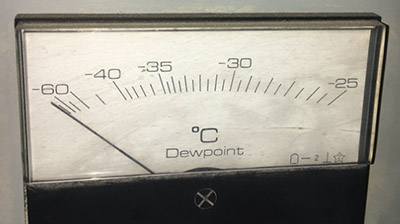
There is always much talk about the need to fix compressed air leaks and inappropriate uses in a plant — but sometimes the wasted flow is hidden inside components such as compressed air desiccant dryers.
A small chemical processing facility is located in an area of the world where temperatures in winter drop down below freezing. Most of their compressed air piping is indoors, but some lines are run outdoors to operate control valves. This duty requires the dew point of the compressed air to be lower than the ambient temperatures, which can full below -40° during the coldest winter months.
The full load capacity of their compressed air system compressors is only 140 cfm, a very small system, and to condition the compressed air a 150 cfm heatless desiccant air dryer was purchased. The dryer consumes about 15% of its nameplate rating when purging, or about 23 cfm. The actual average compressed air flow in this plant, including the dryer is about 55 cfm.

The dryer was purchased with a dew point controller that is designed to turn off the dryer purge when the dew point of the dry compressed air it produces becomes drier than -40. But in this case, the controller has been turned off for some reason, allowing the dryer to continue to cycle for no reason, wasting about 42% of all the compressed air the air compressor produces, costing about $5,000 per year in compressed air costs. Required purge for a desiccant dryer is 15%.
What makes this particularly troublesome is the fact that only 2 cfm of the average compressed air flow goes outdoors and actually needs desiccant drying. To make dried air in this case the dryer consumes 12 times the actual requirement.
A better solution for this demand would be the use of refrigerated drying with a small point of use desiccant or membrane dryer for the outdoor requirement, or better yet, the use of electric control valves.
For the time being the plant is educating their compressed air system operators to simply turn the air dryer control selector switch and operate the dryer in dew point control, as indended. A simple flick of the wrist will save them about $3,000 per year in wasted dryer purge.

I know this dryer and if they turn the knob to Autodew (1), they will lose the dewpoint. This is why they leave it in the fixed cycle position. To insure proper dewpoint. This type of analyser requires maintenance every 2 weeks approx. The probe is made out of glass and two platinum wires wound around them. You must condition them with fluoric acid every two weeks. To do so, you must disconect the proble, clean it gently with a tooth brush and rubbing alcool. Let it dry. Then with a small pintch dropper add a few drops of acid on it. Plug it, push the test switch on the electronic board that will boil off excess humidity and set the acid. Then put the probe back in its sampling shell.
The problem.is that this probe is maintenance intensive and people ztops doing it and when it fails, it fails in the dry position. If you really want something safer for dew point control, I’d replace the aurodew system completely. But price vs dryer size is not worth it. Change for a ŕefridge as mentionned and a point of use for tge external lines.
Note, Xebec stopped making these types of autodew controls around 2000. I was the service manager at that time there.